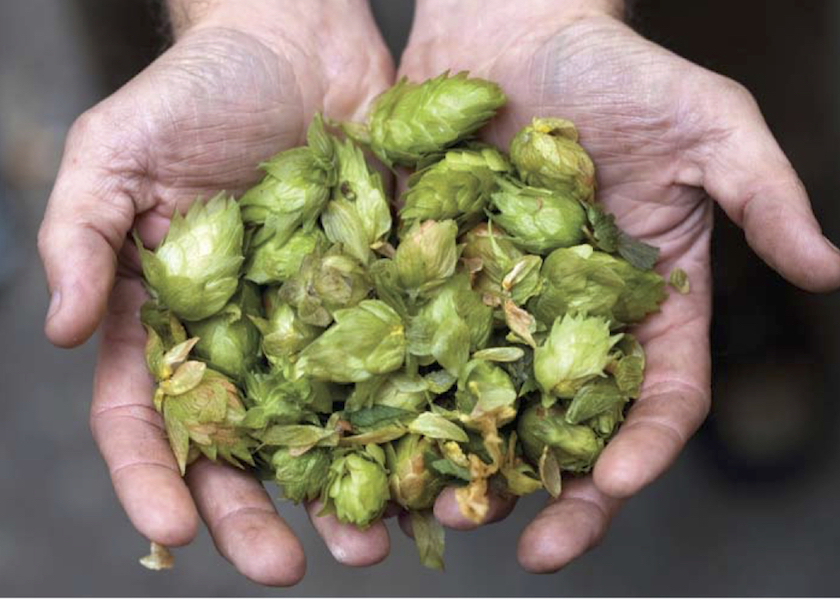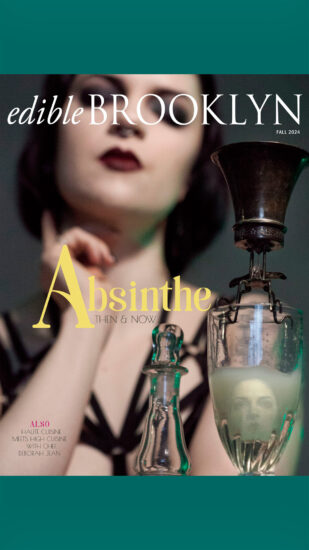In the 19th century, hops-the aromatic flowers that give beer its bitterness-were one of New York State’s most important crops. In Ben Granger’s Sunset Park garden, they still are. And if he has his way, they might again become-if not a major state product-at least a significant Brooklyn harvest. “I want to have a hop consortium in Brooklyn,” he says. A dozen or so gardeners, he argues, could raise enough hops to interest a local brewery. “The marketability is insane. And it would be cool if we could turn it back into a cash crop.”
Granger is a hop fanatic. Visit his garden and before you know it he’ll be squeezing hop cones under your nose so you can appreciate their different aromas. He brags about his hop bag, designed to add even more hop flavor to beer by forcing it through a bed of hops. And, recently, when a gardener told him she’d pulled up an uber-aggressive hop plant, he felt indignation: “Great,” he recalls thinking. “You had a healthy hop plant and you murdered it.”
So it’s no surprise he’s nostalgic for the glory days of Empire State hops. Granted, even a consortium—let alone Granger’s garden—wouldn’t be a drop in the proverbial bucket compared to the whopping 60 million pounds grown in New York in 1870, when the state was the world’s biggest hop exporter. But in his backyard, stuffed as it is with strawberries, raspberries, tomatoes, herbs and much more, hops-more than a dozen varieties of them-are by far the biggest crop, climbing up all the fences as well as an old iron pole at the back of the garden. When Granger cuts them down-which is what he was doing on a hot August Saturday last year, perched 20 feet up on the pole-the pile practically covers the garden. That’s not the best way to harvest hops, Granger admits. Ideally, hop flowers should be harvested one by one as they ripen, like raspberries. But that takes a lot of time and a tall set of stilts, and Granger doesn’t have either.
Granger has a professional interest in beer–he’s manager and part owner of Bierkraft, the six-year-old Park Slope mecca that offers the likes of Captain Lawrence Nor’ Easter and Allagash Tripel (as well as house-made brisket and sauerkraut) and draws suds snobs from Manhattan and beyond. But he’s also a passionate home brewer who took up the craft five years ago after a single lesson from his father-in-law. Many of Brooklyn’s short-on-space home brewers rely on packages and powders-think malt syrup and dried hops. But Granger, who’s as enthusiastic about farming as he is about brewing, has the room-and the inclination-to use handpicked and homegrown ingredients aplenty. He’s made beer with tangerine juice, Greenmarket cherries, even local Tristar strawberries. “I’m hoping next year, that will be big enough to make beer with,” he says, pointing to a wormwood plant. “It’s supposed to be awesome.”
Unfortunately, Granger can’t get all the ingredients he needs to brew beer locally. Nobody’s malting barley in New York (though there are rumors someone somewhere up the Hudson is trying), so Granger buys his from Red Hook’s Sixpoint brewery. And, though Granger could brew the beer with wild yeast, it’s a lot safer to go with a tested, professionally made strain. Still, the beer he’s aiming for now is designed to showcase local flavors: his own hops and the Brooklyn Bee‘s Fort Greene honey (which happens to be produced on my roof, by my husband’s bees). And he’s going to make it in the backyard at Bierkraft, where most of the employees are home brewers. “There’s always brewing going on at the shop,” Granger says.
Granger likes to say that while wine was an accident, beer was an invention. Anyone can make wine-of a sort, anyhow-by leaving grape juice out to ferment. But brewing beer from scratch takes many steps, a good deal of equipment, and at least a rudimentary knowledge of chemistry. As Granger is about to demonstrate.
On brewing day, as staff members and friends wander in and out (often with a beer in hand), Granger, in his invariable weekend outfit of T-shirt and faded, ripped, duct-tape-patched overalls, fiddles with a Rube Goldberg contraption of tanks, burners, tubes and gauges that dominates the space. The flame under the first of the kettles, the hot liquor tank, is on high, bringing 15 gallons of Brooklyn water (“some of the best brewing water ever,” Granger boasts) to 180 degrees.
For this batch of beer, Granger’s using 35 pounds of malt and all 12 pounds of his hop harvest (some dried and some flashfrozen). That’s a whole lot of ingredients for just 10 gallons of beer; a standard English bitter or American ale would use half that much malt and a quarter of the hops to yield the same amount. But Granger’s not looking to use his ingredients efficiently, as a commercial brewer would; he’s aiming for a rich, high-octane beer that will show off his hops. “I have a bottle of beer every night,” he says, “and I want a beer. If I’m going to drink water, I’ll go out and drink water.”
Every brewer follows the same basic steps: add the hot water to the malt; cook it to extract as much sugar and flavor as possible; add the hops and extract all their flavor and bitterness; cool the mixture down; and add the yeast. But exactly how to follow those steps is a matter for ferocious argument. Granger believes he gets the most flavor and sugar out of the grains through what he calls “stepped mashing”: turning down the heat periodically to give the mixture more time to steep on its way to a boil. As the mixture (which looks-and tastes-like very sweet oatmeal) cooks, the starch is converted to sugar and is absorbed by the water. When the grains taste like nothing at all, meaning all its sugar has been absorbed by the water, Granger prepares to strain the liquid from the mash tun into the brew kettle, where it will finally make the acquaintance of his hops.
But trouble is brewing: the mash mixture is so thick it clogs thepump that’s keeping it circulating. The water at the bottom of the kettle, nearest the flame, gets so hot it turns to steam, creating a waterless pocket. If Granger can’t break up the jam, the grain will burn, and the beer will taste not of homegrown heirloom hops but of scorched soup. Every home brewer in the shop converges on the kettle as Granger, atop a stool, pokes at the mixture with a massive spatula. No luck. Finally he opens the drain on the mash tun. A cloud of steam hisses out. ‘It’s on,” he declares, raising his left hand in a gesture that looks a lot like prayer as he watches the liquid begin to move again. “Hey, it’s going now, man. Whew!”
Malt produces the sugars necessary to ferment beer, but the mixture now in the malt tun is thick, syrupy and–frankly–slightly disgusting. It’s the hops that will make it taste like beer. And it’s not just bitterness they add. Depending on the variety, hops can taste of citrus, passion fruit, pine, Hawaiian Punch, grass or even skunk.
But capturing both hops’ flavor and bitterness is a tricky business, because they come from different chemicals that have opposite reactions to heat. Hops are full of extremely bitter alpha acids, which can only be extracted by long boiling; they’re also full of flavorful, aromatic oils that disappear when boiled. Granger has complicated things even more by adding both dried and fresh hops to the brew. Fresh hops provide the most delicate flavor but, if left in too long, can make the beer taste like grass.
Every brewer has his own formula for blending these extremes. Granger’s is to add the hops gradually, saving half-including all the fresh hops-for the very end. This gives the acids a long boil while leaving plenty of oils to steep off the flame.
In the old days, Granger says, brewers would simply leave the wort to cool. “But this is 10 gallons of water saturated with sugar. It’ll take forever.” Instead, on its way to the barrels where it will ferment, he strains the wort through a set of interlaced tubes that surround it with cold water. After adding the yeast–a Sixpoint variety called (yes, really) “007”–Granger puts on a lock that keeps air out but lets gas escape. Now Mother Nature is in charge. And she, says Granger, “is a powerful beast. You can influence her, but you can’t change her mind.”
Unlike many brewers, who base their decisions primarily on chemistry–namely alcohol content–Granger taste-tests daily. As the beer ferments, it lightens in flavor, loses some sweetness and develops a little carbonation. The hop flavor mellows. After 10 days, all the sugar has been converted to alcohol. At this point, it’s beer. At about 9 percent alcohol, it’s pretty strong beer. But it’s not yet very good beer.
Now it’s time for a secondary fermentation-and the honey: two pounds of it. Granger siphons the brew into fresh barrels and pours in almost all of the honey, saving just a bit to prime the bottles. (He’s an enthusiast for brewing with honey: “If I have a beer that goes awry, honey is my favorite fixing tool. And you get all sorts of different flavors that aren’t offensively sweet.”) Ten days later, Granger bottles the beer and adds a bit more honey to develop a head, then puts it in a store cooler to age.
On a Saturday in March, about eight of us got together to taste the beer, which had reached an alcohol level of 11.5 percent. Let’s just say it was well worth all Granger’s effort. A rich amber beer with tight bubbles, dry, hoppy and fruity, tasting of honey but without a hint of sweetness, and none of the heat you’d expect in such a high-alcohol brew. A beer to savor. A beer to wish you could take home more than two bottles of.
Later I ask Granger–as a professional–if you could buy a beer like that. Oh, yeah, he says. Craft brewers make limited batches all the time, partly for fun and partly for the cachet. “They’ll brew it with honey, and age it for a year in Tuthilltown barrels. Beer geeks line up for miles to get it, and it gives them a whole hell of a lot of name recognition.”
So how much would this beer sell for if it were commercially made, I ask. Granger mulls it over: the honey, the fresh hops, the two fermentations, the cold conditioning . . . .
About $30 to $35 a bottle, he says.
Maybe that Brooklyn hops consortium isn’t such a crazy idea after all. (Interested parties can contact Granger at good.hops@ gmail.com.)
Vine Time: Bierkraft’s Ben Granger creates his homebrew’s bitterness with his own humulus lupulus.
Even if every Brooklyn backyard boasted a hop harvest, it wouldn’t be a drop in the proverbial bucket compared to the 60 million pounds grown in New York in 1870. Still, Ben Granger’s proud of his plants—over a dozen varieties, climbing up the fences as well as an old iron pole at the back of the garden.



